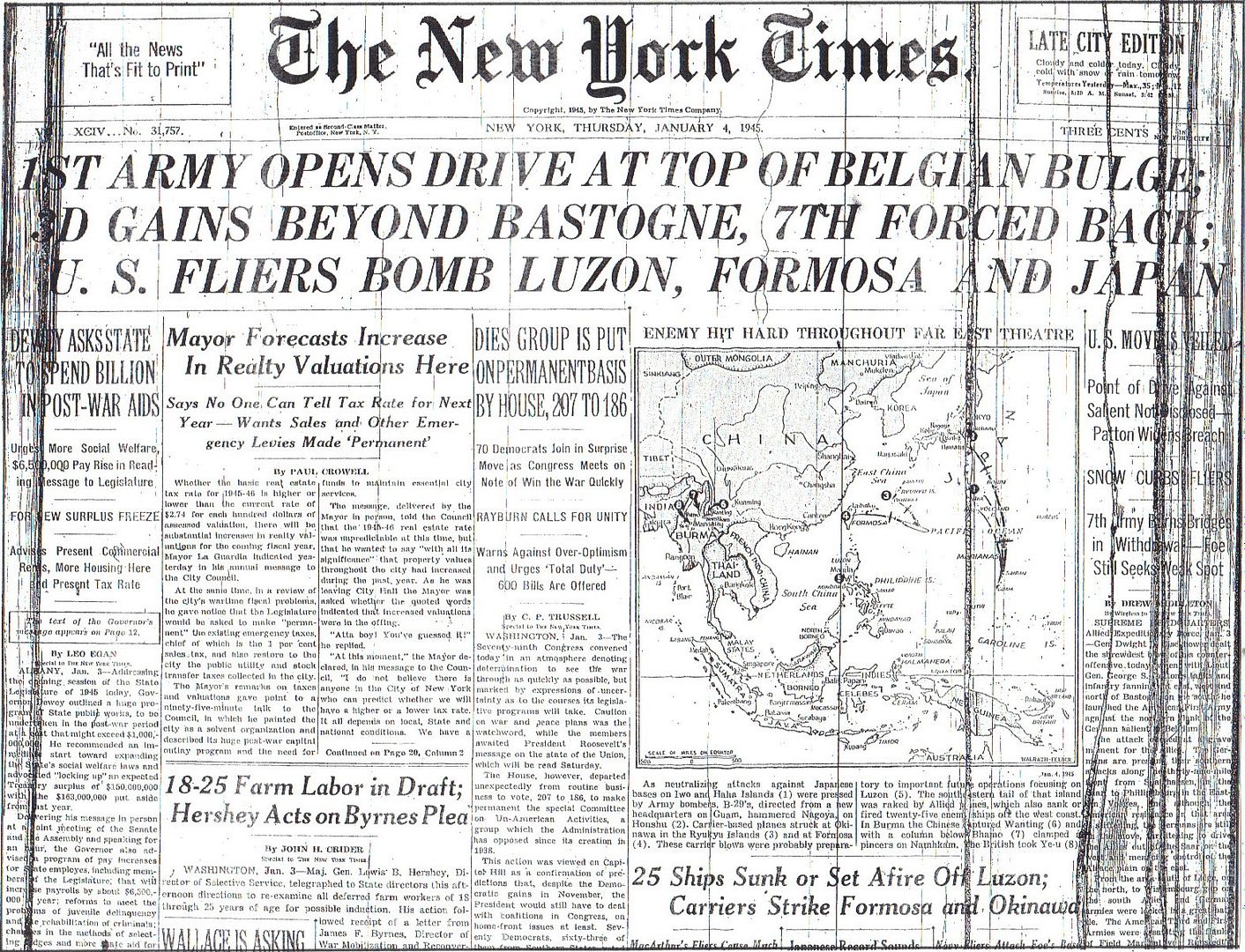
Posted on 01/04/2015 4:42:44 AM PST by Homer_J_Simpson

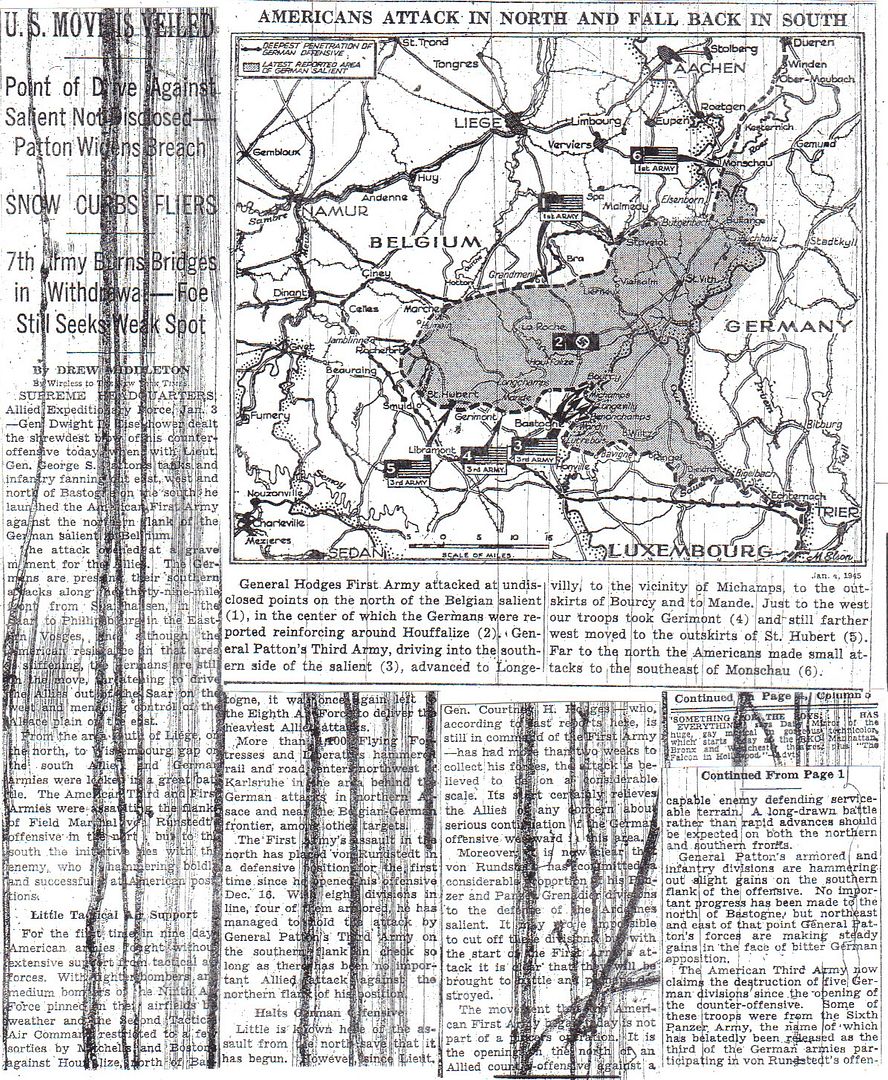
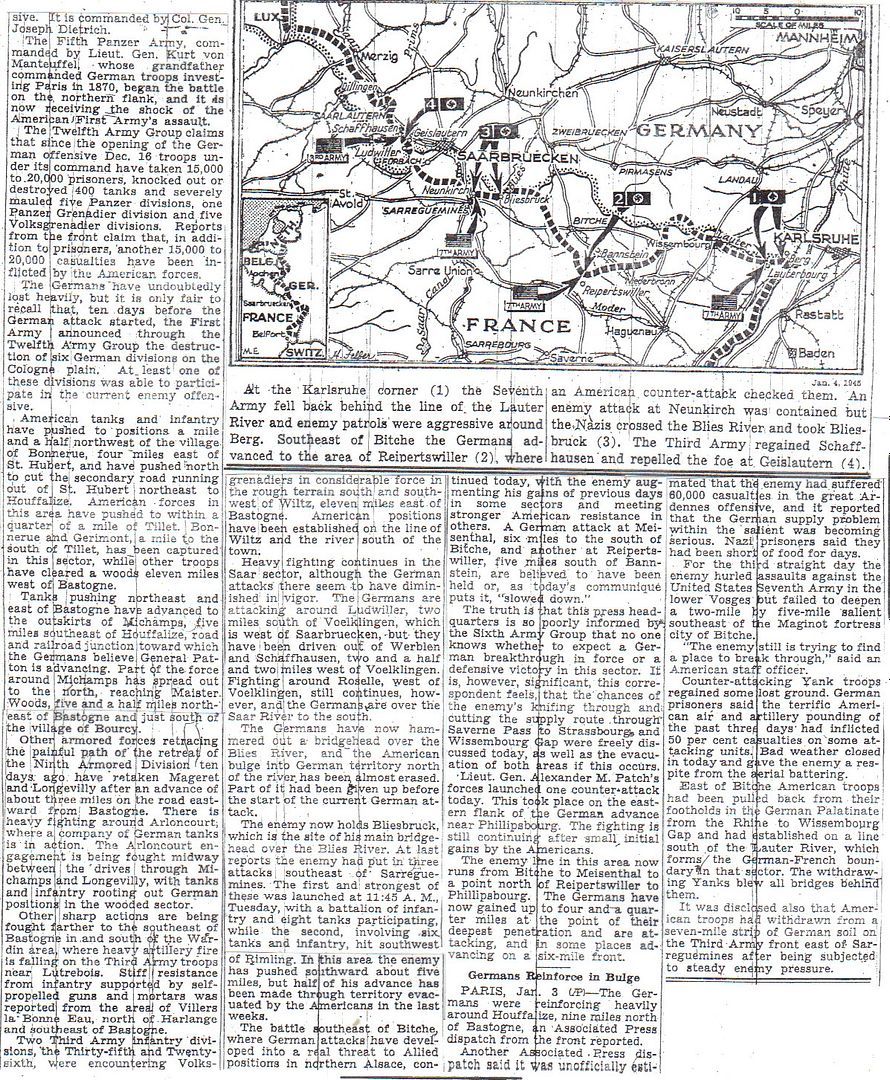
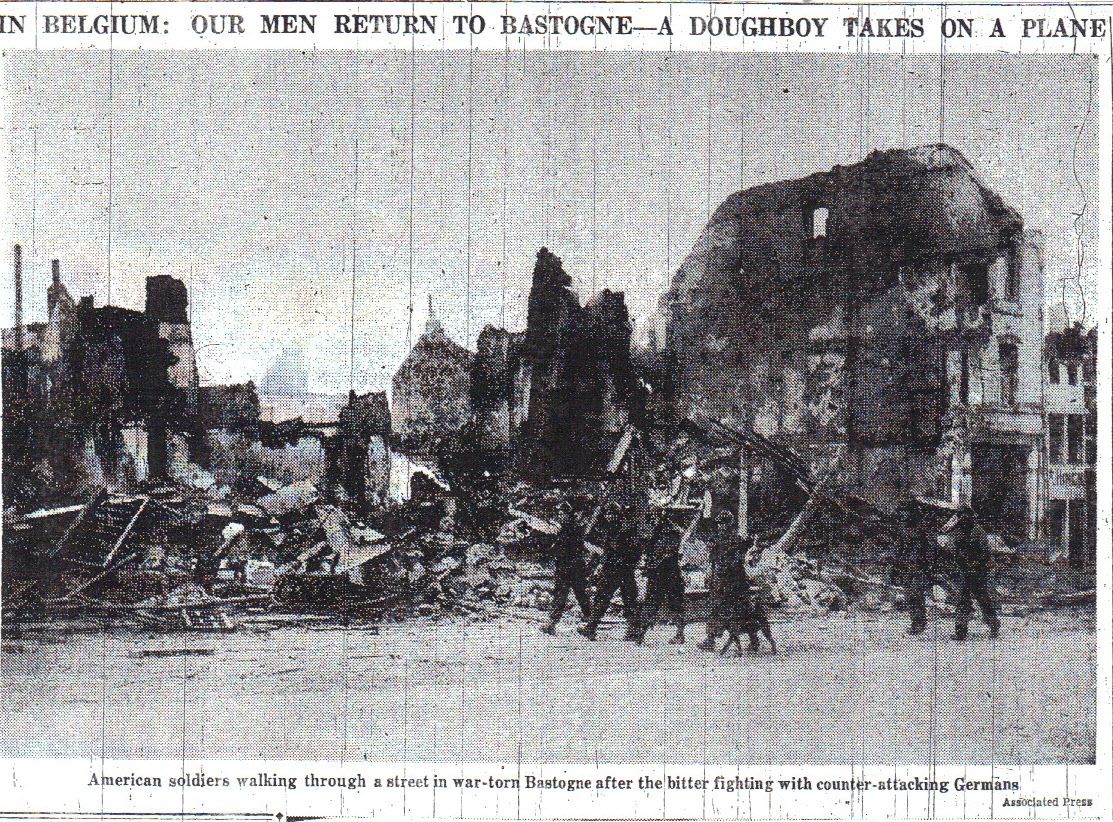
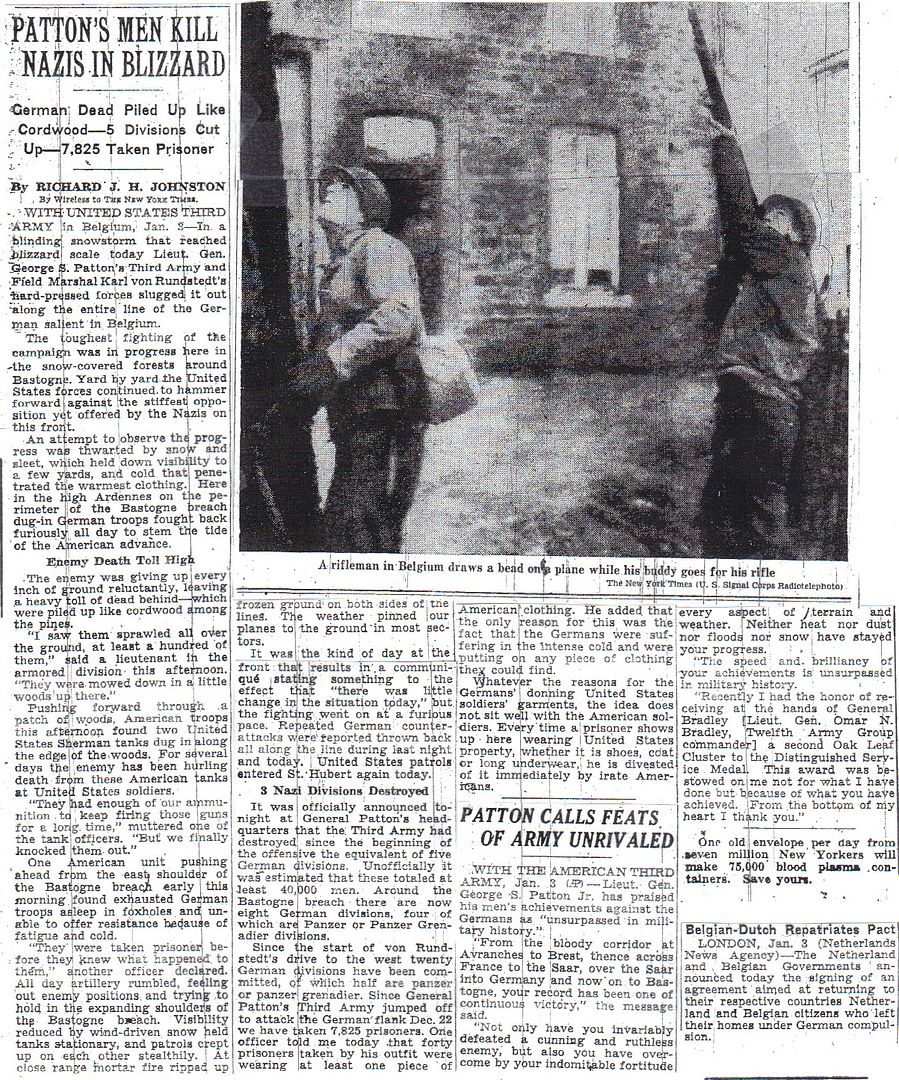
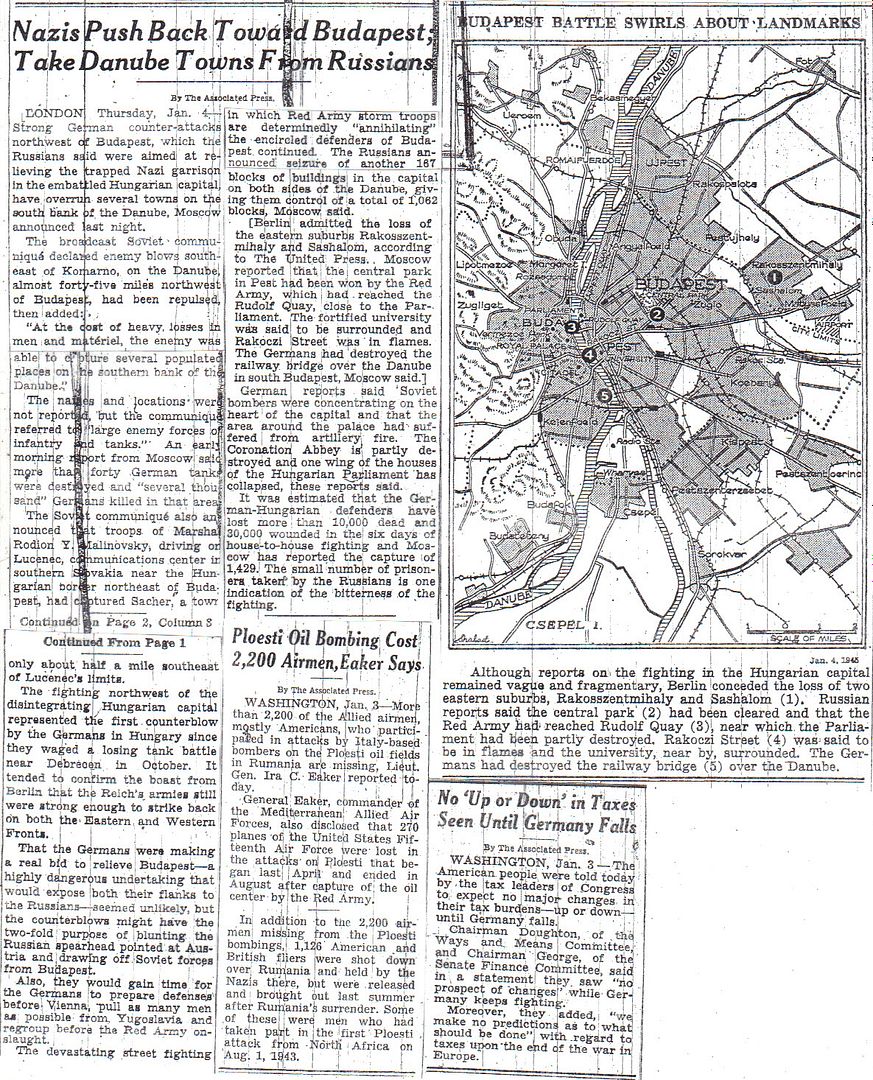
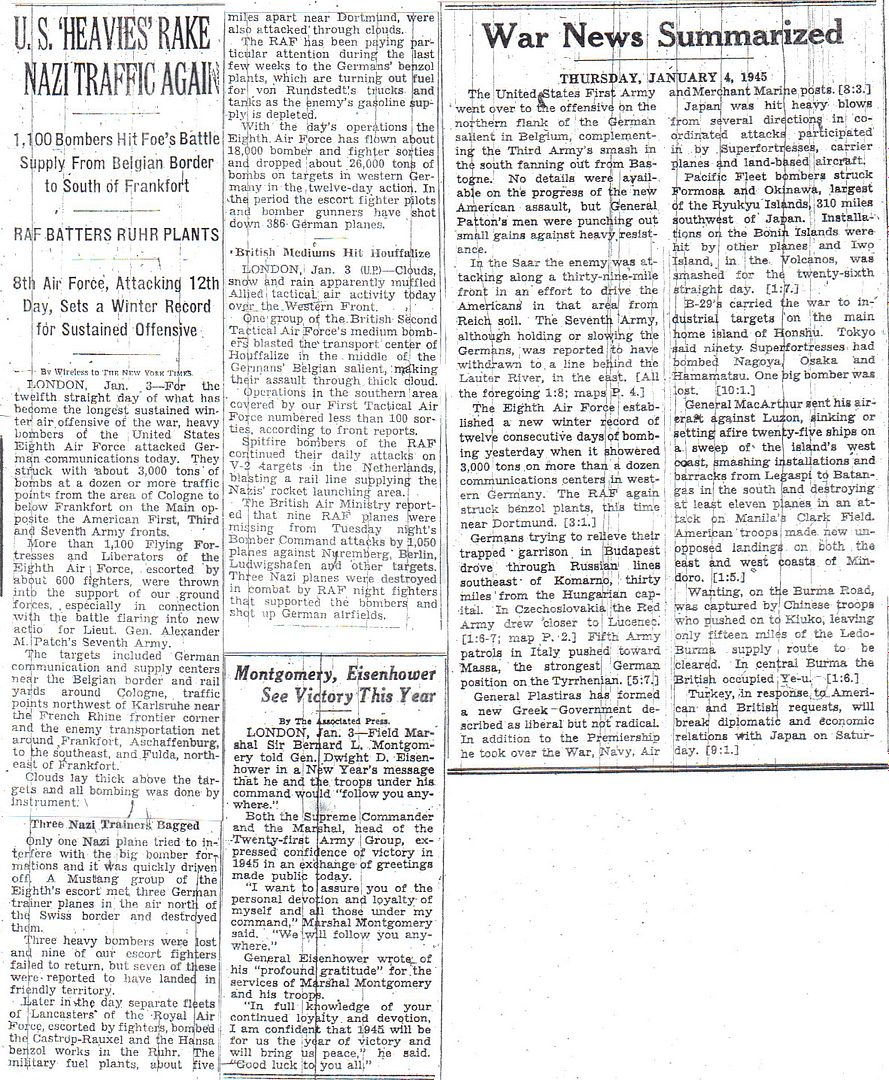
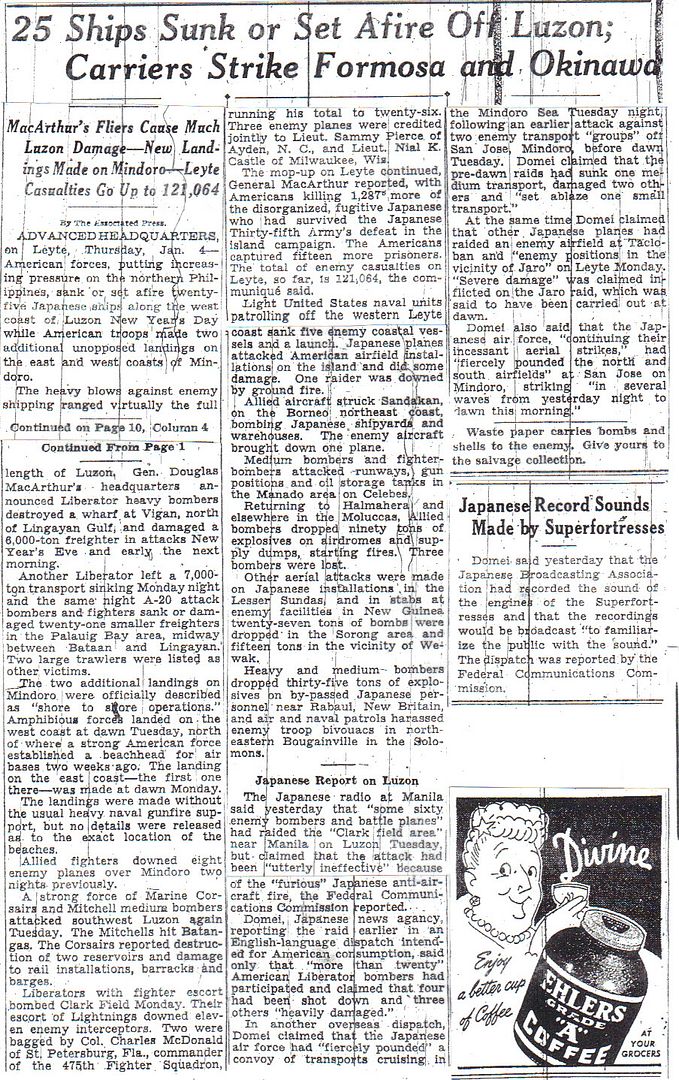
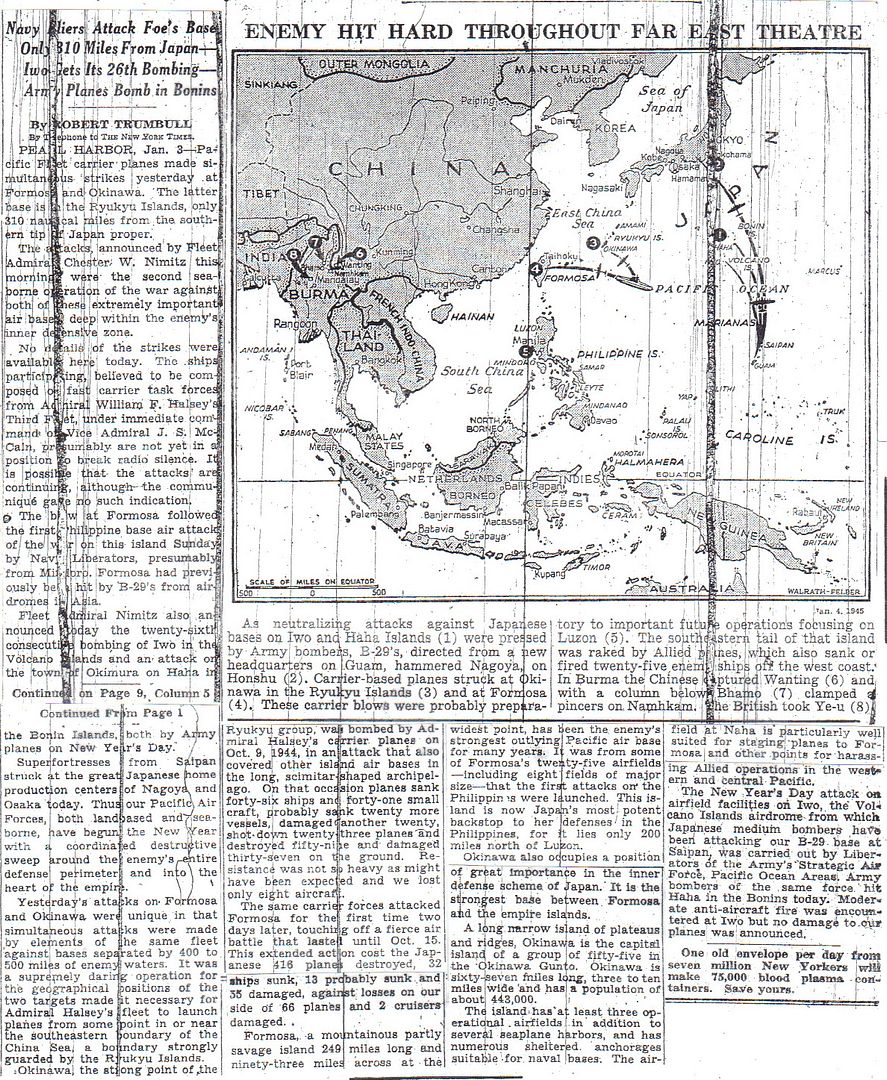
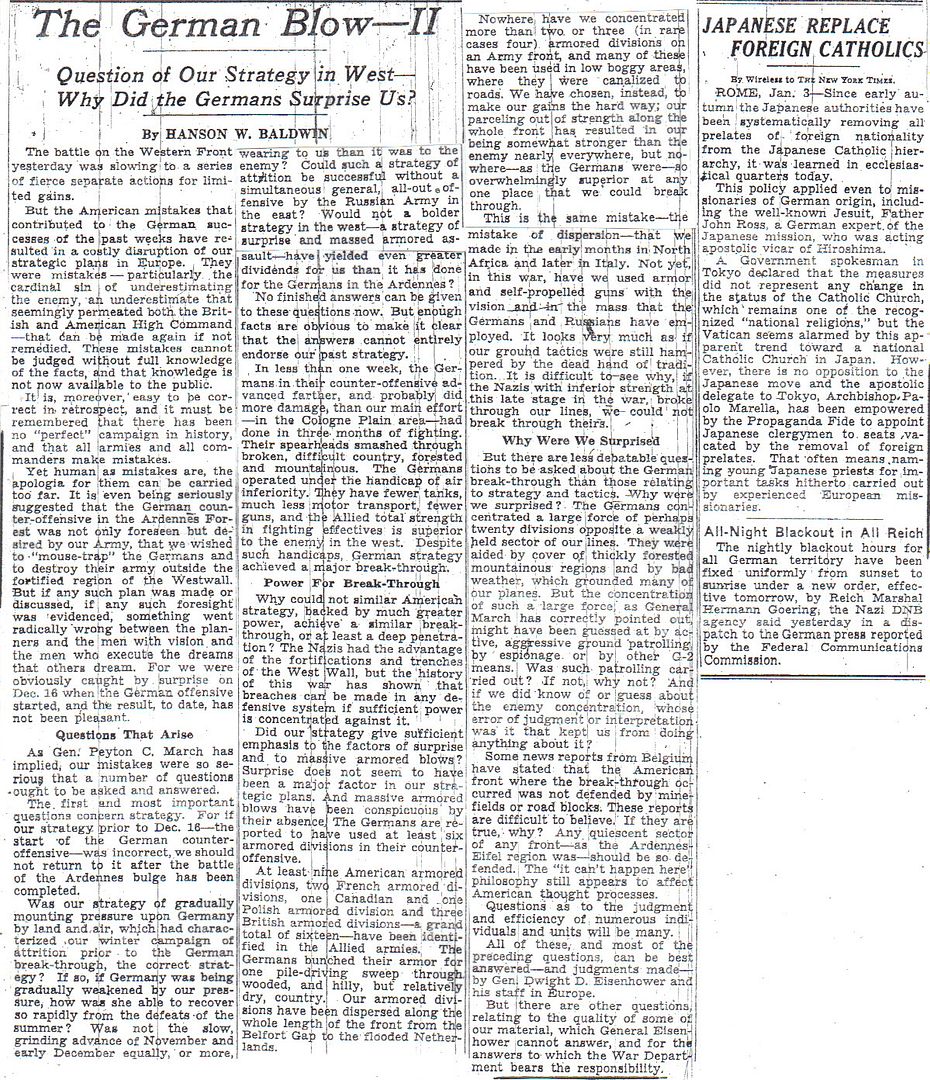

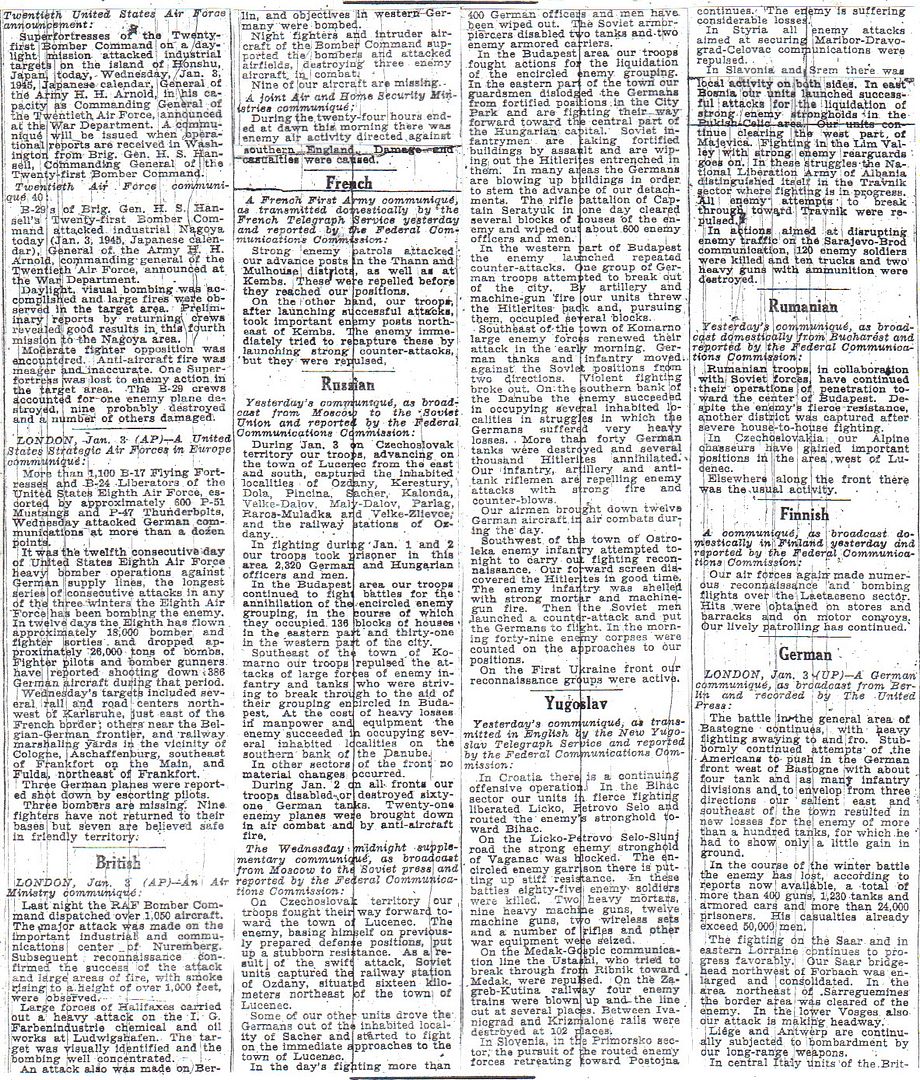
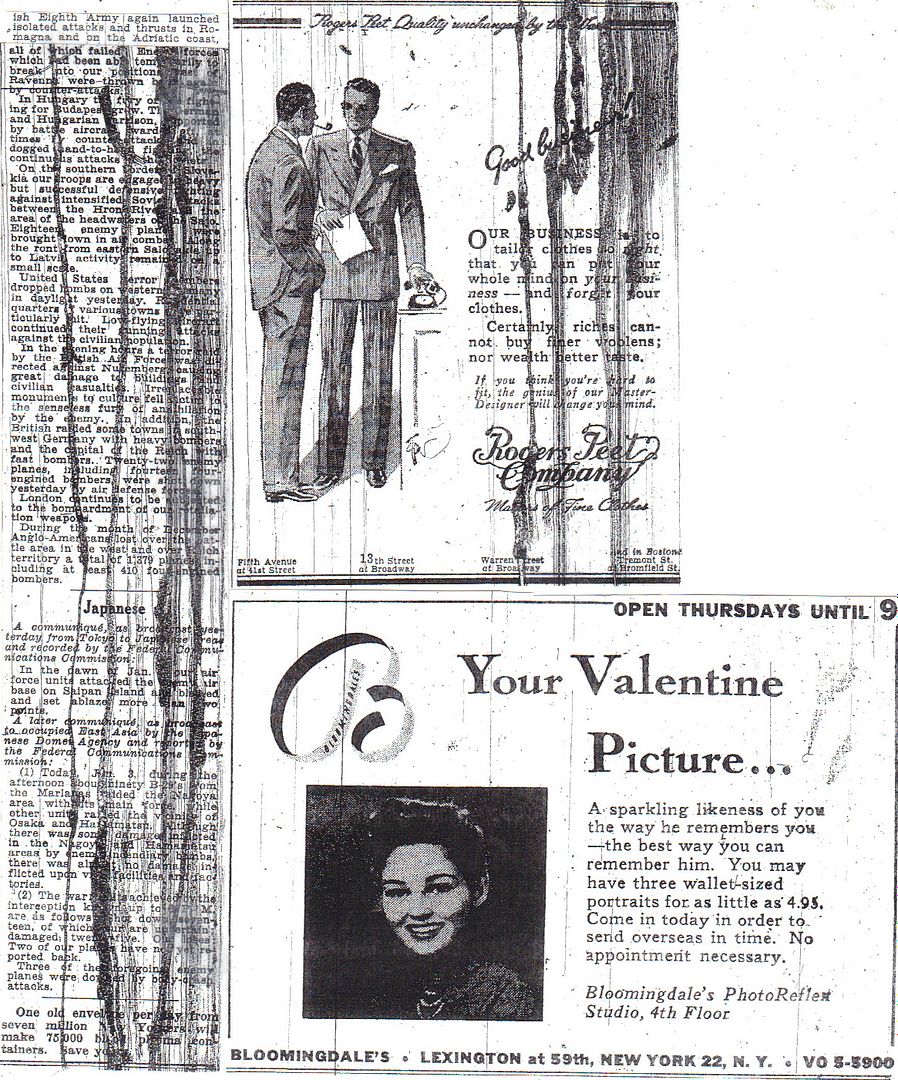
U.S. Move is Veiled (Middleton) – 2-3
In Belgium: Our Men Return to Bastogne – A Doughboy Takes on a Plane (photos) – 4-5
Patton’s Men Kill Nazis in Blizzard (Johnston) – 5
Nazis Push Back toward Budapest; Take Danube Towns from Russians – 6
U.S. ‘Heavies’ Rake Nazi Traffic Again – 7
War News Summarized – 7
25 Ships Sunk or Set Afire Off Luzon; Carriers Strike Formosa and Okinawa (Trumbull) – 8-9
The German Blow-II (Baldwin) – 10
The Texts of the Day’s Communiques on the Fighting in Various War Zones – 11-13
January 4th, 1945 (THURSDAY)
UNITED KINGDOM: During the night of 4/5 January, the USAAF Eighth Air Force flies Mission 779: one B-17 Flying Fortress and two B-24 Liberators drop leaflets in the Netherlands, Belgium and Germany; one B-24 is lost.
BELGIUM: In the British Second Army area, XXX Corps opens an offensive west of the Ourthe River, protecting the U.S. First Army right. From the Marche-Hotton road, the 53d Division drives south abreast the U.S. VII Corps. The British 6th Airborne Division meets determined opposition south of Rochefort.
In the U.S. First Army’s VII Corps area, the 2d Armoured Division captures Beffe, contains counterattacks near Devantave, seizes Lamormnil, and reaches the edge of Odeigne. The 3d Armoured Division takes Baneux, Jevigne, and Lansival and gains a bridgehead at Groumont Creek. In the XVIII Corps (Airborne) area, the 82d Airborne Division advances its line to include Heirlot, Odrimont, the wooded heights north and northeast of Abrefontaine, St Jacques, Bergeval, and Mont de Fosse; on the extreme left patrols push to the Saim River.
In the U.S. Third Army’s VIII Corps area, the 87th Infantry Division attack is halted by resistance near Pironpr. An attack of the 17th Airborne Division evokes strong reaction in the Pinsamont-Rechrival-Hubermont area. German attacks in the 101st Airborne Division sector are ineffective. In the III Corps area, the 6th Armoured Division is repeatedly attacked in the Mageret-Wardin area east of Bastogne, and withdraws to shorten the line. The 35th Infantry Division clears Lutrebois but is still unable to take Harlange, Luxembourg. The 26th Infantry Division gains a few hundred yards.
Flamierge: Staff Sergeant Isadore S. Jachman, U.S. Army, Company B, 513th Parachute Infantry Regiment. Awarded the MoH for conspicuous gallantry and intrepidity above and beyond the call of duty at Flamierge, Belgium, on 4 January 1945, when his company was pinned down by enemy artillery, mortar, and small arms fire, 2 hostile tanks attacked the unit, inflicting heavy. casualties. S/Sgt.
Jachman, seeing the desperate plight of his comrades, left his place of cover and with total disregard for his own safety dashed across open ground through a hail of fire and seizing a bazooka from a fallen comrade advanced on the tanks, which concentrated their fire on him. Firing the weapon alone, he damaged one and forced both to retire. S/Sgt. Jachman’s heroic action, in which he suffered fatal wounds, disrupted the entire enemy attack, reflecting the highest credit upon himself and the parachute infantry. (Patrick Holscher)
FRANCE: In U.S. Seventh Army’s XV Corps area, the 44th Infantry Division tries vainly to clear Frauenberg and Gros Rederching. In a limited attack, the 36th Infantry Division takes a hill between Lemberg and Goetzenbruck. In the VI Corps area, the 45th Infantry Division, continuing the fight to reduce the Bitche salient, drives to the outskirts of Wingen; attacks northeast across the Wingen-Wimmenau road to ease pressure on Reipertsweiler; fights to open the Reipertsweiler-Wildenguth road, taking Saegmuhl and making contact with elements cut off in Wildenguth; and clears about half of Philippsbourg. Task Force Linden’s line along the Rhine River is extended to include the zone held by Task Force Herren.
The USAAF Eighth Air Force flies Mission 780: ten of 12 B-24 Liberators dispatched to hit the Coubre Point Coastal battery near Bordeaux hit the target using H2X radar.
During the night of 4/5 January, RAF Bomber Command dispatches 347 Lancasters and seven Mosquitos to bomb Royan; 350 bomb the town with the loss of four Lancasters and two more which collide behind Allied lines in France and crash. This is a tragic raid with a strange, and disputed, background. Royan was a town situated at the mouth of the River Gironde in which a stubborn German garrison was still holding out, preventing the Allies from using the port of Bordeaux. The task of besieging the town had been given to 12,000 men of the French Resistance commanded by Free French officers appointed by Brigadier General Charles-Andre de Gaulle, Prime Minister of the Provisional French Government. The commander of the German garrison recognized the Resistance units as regular forces and the normal rules of warfare are observed. The French, lacking artillery, made little progress with their siege. The German commander gave the inhabitants of the town the opportunity to leave but m any preferred to stay in order to look after their homes. It is believed that there were 2,000 civilians at the time of the raid. On 10 December 1944, a meeting took place at the town of Cognac between French officers and an American officer from one of the tactical air force units in France. After a meal, at which much alcohol is supposed to have been consumed, the American officer suggested that the German garrison at Royan should be “softened up” by bombing. He was assured by the French that the only civilians remaining in the town were collaborators, which was not correct. The suggestion that the town be bombed was passed to SHAEF (Supreme Headquarters Allied Expeditionary Force), which decided that the task should be given to Bomber Command: “To destroy town strongly defended by enemy and occupied by German troops only.” It is said that SHAEF ordered a last-minute cancellation because of doubts about the presence of French civilians but the order, if issued, was not received by Bomber Command in time. The attack is carried out by two waves of bombers, in good visibility conditions, in the early hours of 5 January. 1,576 tons (1 430 metric tons) of high-explosive bombs, including 285 4,000- pound (1 814 kilogram) “blockbuster” bombs, are dropped. Local reports show that between 85 and 90 per cent of the small town is destroyed. The number of French civilians killed is given as “500 to 700”and as “800” by different sources. Many of the casualties are suffered in the second part of the raid, which took place an hour after the first and caught many people out in the open trying to rescue the victims of the first wave of the bombing trapped in their houses. The number of Germans killed is given as 35 to 50. A local truce is arranged and, for the next ten days, there is no fighting while the search for survivors in wrecked houses continues. There are many recriminations. Bomber Command is immediately exonerated. The American air-force office r who passed on the original suggestion to SHAEF is removed from his command. The bitterest disputes takes place among the Free French officers and accusations and counter-accusations continued for many years after the war. A French general committed suicide. De Gaulle, in his Memoires, blamed the Americans: “American bombers, on their own initiative, came during the night and dropped a mass of bombs.” The German garrison did not surrender until 18 April.
Lieutenant Colonel Clifford Heflin flew the first USAAF mission in Operation CARPETBAGGER from Tempsford, Bedfordshire, England, to France to drop supplies at night to resistance forces.
GERMANY: During the night of 4/5 January, RAF Bomber Command dispatches 66 Mosquitos to two targets: 59 bomb Berlin and six hit Neuss without loss. Some of the Light Night Striking Force Mosquitos which attacked Berlin on this night flew two sorties each. These Mosquitos took off in the early evening, bombed Berlin returned and changed crews, and then flew to Berlin again. This method of augmenting the Mosquito campaign against Berlin was used several times during the long nights of midwinter.
ITALY: USAAF Twelfth Air Force medium bombers hit bridges at Lavis and Calliano; fighters and fighter-bombers interdict Po Valley communications and hit an ammunition dump at San Felice del Benaco;
The USAAF Fifteenth Air Force hits a number of transportation targets. The targets are (numbers in parenthesis indicate number of aircraft bombing and number lost, e.g., 97-1):
- City: Grado (1-0)
- Marshalling yards: Bolzano (44-1), Bronzolo/North (38-0), Bronzolo/South (43-0), Padua (17-0), Trento/North (53-3), Verona/Porto Nouvo (132-1), Verona/Porto Vescova (67-0) and Vicenza (13-0).
- Railroad siding: Trento (23-0).
During the night of 4/5 January, USAAF Twelfth Air Force A-20 Havocs on a south Po Valley intruder mission bomb the Modena area. Bad weather cancels all other operations. Meanwhile, 43 heavy bombers of the RAF’s No. 205 (Heavy Bomber Group bomb the railroad bridge at Latisana.
YUGOSLAVIA: Nine USAAF Fifteenth Air Force B-24 Liberators drop supplies to Yugoslav partisans.
During the night of 4/5 January, 16 heavy bombers of the RAF’s No. 205 (Heavy Bomber) Group drop supplies to partisans.
CHINA: Four USAAF Fourteenth Air Force B-24 Liberators bomb the Ft Bayard area and the Samah Bay area on Hainan Island. Twenty fighters hit targets of opportunity around Lohochai, Sinyang and Hankow.
BURMA: In the Allied Land Forces South East Asia (ALFSEA) area, the Indian XV Corps completes occupation of Akyab, key port and air base on the Arakan front.
In the Northern Combat Area Command (NCAC) area, the U.S. 475th Infantry Regiment (Long Range Penetration, Special) finishes crossing the Shweli River. The U.S. 124th Cavalry Regiment (Special) reconnoitres for a crossing site over the Shweli River while awaiting an airdrop.
Thirteen USAAF Tenth Air Force B-25 Mitchells, escorted by 12 P-47 Thunderbolts, bomb Namsang Airfield; 12 P-47s hit bypass road bridges at Inailong and Bawgyo, damaging approaches to the latter; troops and supply areas are hit at Man Kat, Hsenwi, Yi-ku, Se-hai, and near Nawnghkio by 36 P-47s and P-38 Lightnings; six P-47s bomb cable and pontoons along the north riverbank at Na-lang; six hit enemy activity near Twinnge and five attack a truck dispersal area and warehouses at Mogok. Transports fly 597 sorties to front areas and forward bases.
Six USAAF Fourteenth Air Force B-25 Mitchells damage a bridge and a warehouse, and destroy two other buildings at Kentung and 21 P-40s on armed reconnaissance pound targets of opportunity in the Wanling area.
THAILAND: Eight USAAF Fourteenth Air Force P-51 Mustangs knock out a bridge at Huizan and damage another.
FORMOSA: USN Task Force 38 continues operations against Japanese airfields and shipping in the Formosa area. Navy planes sink three auxiliary submarine chasers and damage an escort vessel and an auxiliary submarine chaser in the Formosa Strait; sink an auxiliary netlayer northeast of Taiwan; and damage a minesweeper near Takao,
EAST INDIES: USAAF Far East Air Forces (FEAF) B-25 Mitchells and P-38 Lightnings hit Tanamon and Sidate on Celebes Island; seven RAAF Beauforts attack Sidate and (P-40) Kittyhawks hit shipyards on Bangka Island. FEAF B-24 Liberators and B-25s, flying small scale strikes, hit airfields on northeast Celebes Island bomb shipyards in northern Borneo.
NEW GUINEA: In Papua New Guinea, Australian Lieutenant General Sir Vernon Sturdee, General Officer Commanding First Australian Army, writes to General Thomas Blamey, Commander in Chief Australian Military Force and Commander in Chief Allied Land Forces South-West Pacific: “I have been anxiously awaiting some Press announcement that the Australian Army still exists in New Guinea, and it seems that the Australian public must be wondering whether we are still in the war.”
COMMONWEALTH OF THE PHILIPPINES: Japanese planes attack Task Groups 77.6 and 77.2 as they continue toward Lingayen Gulf, Luzon. At the request of General of the Army Douglas MacArthur, Commander-in-Chief South-West Pacific Area, Admiral William Halsey, Commander of the Third Fleet, orders Task Force 38 to extend its coverage of Luzon southward on 6 January. The main body of the Luzon Attack Force sorties from Leyte Gulf after nightfall. U.S. X Corps, Eighth Army, terminates offensive operations on Leyte.
USAAF Far East Air Forces (FEAF) B-24 Liberators bomb Puerto Princesa on Palawan Island while B-25 Mitchells hit a railroad and highways in the San Pedro area on Luzon Island. Other B-24s and B-25s, flying small scale strikes, hit airfields on southern Luzon and Mindanao Islands and in the central Philippine Islands.
VOLCANO ISLANDS: Thirteen USAAF Seventh Air Force B-24 Liberators bomb Iwo Jima. During the night of 4/5 January, ten more B-24s hit the island with individual harassment strikes.
PACIFIC: The US 3rd Fleet carrier planes attack targets on FORMOSA and the southern Ryukyu Islands as well as the Pescadores.
Fleet Air Arm aircraft from the aircraft carriers Indomitable, Indefatigable and Victorious launched a major air strike against the Japanese oil refineries at Pangkalan Brandan in Sumatra.
Escort carrier USS Ommaney Bay sunk by a Japanese kamikaze attack south of Mindoro, Philippine Islands.
PACIFIC OCEAN: In the Sulu Sea northwest of Panay Island, Philippine Islands, the USN escort aircraft carrier USS Ommaney Bay (CVE-79) is crashed on the starboard side by a Japanese twin-engine Kamikaze. Composite Squadron Seventy Five (VC-75) with FM Wildcats and TBM Avengers is aboard. Two bombs are released; one of them penetrates the flight deck and detonates below, setting off a series of explosions among the fully-fuelled aircraft on the forward third of the hanger deck. The second bomb passes through the hanger deck, ruptures the fire main on the second deck, and explodes near the starboard side. Fires, fuelled by fuel and ammunition, prevent other ships for coming close and by 1750 hours the entire topside area had become untenable, and the stored torpedo warheads threatened to explode at any time. The order to abandon ship is given and at 1945 hours, the ship is sunk about 53 nautical miles (98 kilometres) northwest of San Jose, Panay, by a torpedo from the destroyer U SS Burns (DD-588). A total of 95 crewmen are lost, including two killed on an assisting destroyer when torpedo warheads on the carrier€™s hangar deck finally explode. The USN now has 66 escort aircraft carriers in commission.
Off San Jose, Mindoro Island, Philippine Islands, a Japanese kamikaze crashes U.S. freighter SS Lewis L. Dyche (carrying bombs and fuses), which disintegrates, killing all hands, including the 28-man Armed Guard; debris from the exploding freighter damages a nearby oiler and a minelayer.
A Japanese Fu Go balloon bomb crashes in the Gulf of Alaska about 391 nautical miles (724 kilometres) east of Unalaska, Territory of Alaska, but it is not recovered.
CAROLINE ISLANDS: U.S. 81st Infantry Division troops on Fais complete search of the island and are withdrawn. Fais Island is located about 52 nautical miles (97 kilometres) east of Ulithi Atoll.
NEWFOUNDLAND: Corvette HMCS Stellarton departed St John’s with Convoy HX-329.
U.S.A.: Two Japanese Fu Go paper balloons land:
- The first which includes the envelope, fragments, rigging and apparatus, lands near Sebastopol, California, at 1815 hours local. Sebastopol is located in northern California about 6.5 miles (10,4 kilometres) west of Santa Rosa.
- Fragments of what is identified as an incendiary type bomb explode in a field 1 mile (1,6 kilometres) south of Medford, Oregon, at 1740 hours local. A whistling sound as if a bomb was falling is heard prior to the explosion. Medford is located about 210 miles (338 kilometres) south of Portland.
Submarine USS Sirago laid down.
ATLANTIC OCEAN: About 1700 hrs, U-1232 attacked the convoy SH-194 four miles off Halifax and reported two ships sunk. SS Polarland was sunk and SS Nipiwan Park damaged. Polarland in station #31 was hit by one torpedo and sank within 15 seconds. Two men rescued themselves on a raft, which floated free and were later joined by three others that came to the surface after the ship sank. The four crewmen and one gunner were picked up about one hour later by HMCS Kentville. The master, one gunner and 15 crewmembers were lost, including all officers.
Interesting to read the speculation on why the Germans surprised us. Hind sight and all that. Thanks.
Books have been written on this subject, but suffice to say that German military leadership in the field was generally excellent. But, evil of the Nazi empire aside, the loss of the war lies entirely at the very top.
Hiya snippy!!! In case ypou missed it, here is a a post from about 3 weeks ago, Tempus Fugit, eh?, about the Allied intel failure in the Battle of the Bulge.
http://freerepublic.com/focus/news/3237285/posts?page=27#27
One thing that folk tend to forget is that the “other side” usually has their own idea as to what is to be done!
Hope you and Samwolf are doing well.
Regards
alfa6 ;>}
Hiya, snippy, great to see you check in!
In my opinion the Allies only had one field army commander capable of pulling off a concentrated armored attack - Patton. It was painfully obvious after Market-Garden that Monty is not the guy. Plus, the British Army is exhausted and short on manpower. Would Monty, Ike and Bradley have ever let him do it? Plus, Third Army is out of position to mount an attack on the Ruhr or north of the Ruhr. It seems political considerations as much as anything dictate Ike's decision on the issue.
De Gaulle was a total pain in the @$$, but in this case he may have stopped the panic in SHAEF about Nordwind and German capability in the south.
Looks like our side is swinging from underestimating the Germans to overerestimating them.
Absolutely.
De Gaulle was a total pain in the @$$, but in this case he may have stopped the panic in SHAEF about Nordwind and German capability in the south.
Yup.
It’s finally 1945. Happy New Year, EV!
There has been more than a whiff of panic on the Allied side. The news blackout didn’t help matters. From Hanson Baldwin to Winston Churchill there has been a sentiment that it’s up to Stalin to save our bacon.
You too!
To be charitable, it’s one thing to be able to look back on events, and quite another to be in the midst of them.
Found the following interesting. The way they check the magnetos before flight. The value of the 500 ft cliff at Guam added a lot of bomb tonnage to the trip. They were flying with new low altitude radar, so the role of pathfinders as mentioned the other day is not needed. Iwo is mentioned, so they were valued its availability.
Absolutely.
It’s interesting how “news” has changed. One obvious factor is the deterioration of communication skills. Hanson Baldwin may get stuff wrong, especially with hindsight, but he can write a decent paragraph.
Today, most of the “news” we get isn’t even news ... it’s just people’s speculation about what might happen in the future, and then other people offering opinion on that, and then comments on the next guy’s opinion. It’s fascinating to watch a “story” develop, as we can do on Free Republic, from the facts of an event through the accumulation of errors, omissions, and interpretation.
Indeed.
Disclaimer: Opinions posted on Free Republic are those of the individual posters and do not necessarily represent the opinion of Free Republic or its management. All materials posted herein are protected by copyright law and the exemption for fair use of copyrighted works.